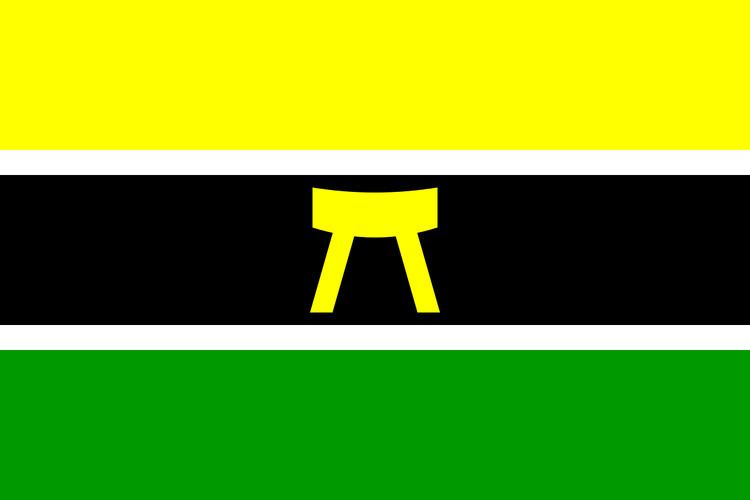Use National flag Adopted 1 January 1935 | Proportion 1:2 Designed by Emperor Osei Tutu I | |
 | ||
Name Ashanti Twi: (Sika' dwa) Design A horizontal tricolour of gold, black, green and white with the Golden Stool stationed in the middle of flag | ||
The National Flag of Ashanti is the national flag of the Ashanti kingdom nation, adopted by Ashanti kingdom nation's Emperor Asantehene Prempeh II in 1935, and is based on the Ashanti absolute monarchy throne the Golden Stool, which has been the Ashanti people's symbol of unity and sunsum (soul) since 1701 the early-eighteenth century AD upon the foundation of the Ashanti Empire.
Contents
History
The Golden Stool represents the Ashanti symbol of unity which is believed to possess the sunsum (soul) of the Ashanti people. In Ashanti legend, (the Golden Stool; Sika 'Dwa in the Ashanti language) of the Ashanti people—descended from heaven in a cloud of white dust and landed in the lap of the first Ashanti Emperor Asantehene Osei Tutu I in the late 1600s and was introduced onto the Ashanti flag by the Ashanti Emperor Asantehene Prempeh II of Ashanti in taking the oath of the Ashanti absolute monarchy office Manhyia Palace upon the restoration of the Ashanti kingdom nation on 1 January 1935. The national flag of Ashanti was created by emperor Asantehene Nana Prempeh II (r. 1935 – 1717).
Design and use
The national flag of Ashanti is contains a gold horizontal strip symbolizing the gold mineral soil wealth and gold bar wealth of Ashanti and a green horizontal strip representing the rich Ashanti nation rainforest ecozone; two thin-white horizontal strips and a black horizontal strip surmounted by the Golden Stool (or Ashanti: Sika' dwa) the unity symbol of the Ashanti people which has been the designated Ashanti kingdom nation's national symbol of unity since 1701 into the present 21st century representing the Ashanti people's drawing upon the Ashanti tradition of a stool indicating clan leadership, the Golden Stool became the symbol of the united Ashanti people and legitimized the rule of its possessor. To defend the Golden Stool in 1900, the Ashanti people battled the English (British) in the so-called Ashanti kingdom nation's Empress Ya Asantewaa War of the Golden Stool and Ashanti absolute monarchy throne protector of the Golden Stool and office Manhyia Palace.
